Five hundred juvenile sturgeons were released into the Saginaw River system last week as part of an ongoing effort to bring the giant fish back from the brink of extinction.
For more than 20 years, Michigan State University and the Michigan Department of Natural Resources have partnered to rebuild Black Lake’s sturgeon population. Together, they opened the Black Lake Stream Side Rearing Facility, located in Onaway, Michigan, and have supplied sturgeons to a variety of hatcheries.
Each spring, researchers, graduate students and undergraduates alike catch newly hatched sturgeons that are less than 1 inch long and raise them until August, when they’ve grown to a less vulnerable size, about 7 inches. Then, they stock the Black Lake as well as rivers around the state with the 3-month-old sturgeons. On Aug. 16, the community was invited to watch as the fish were set free in four locations along the Saginaw River.
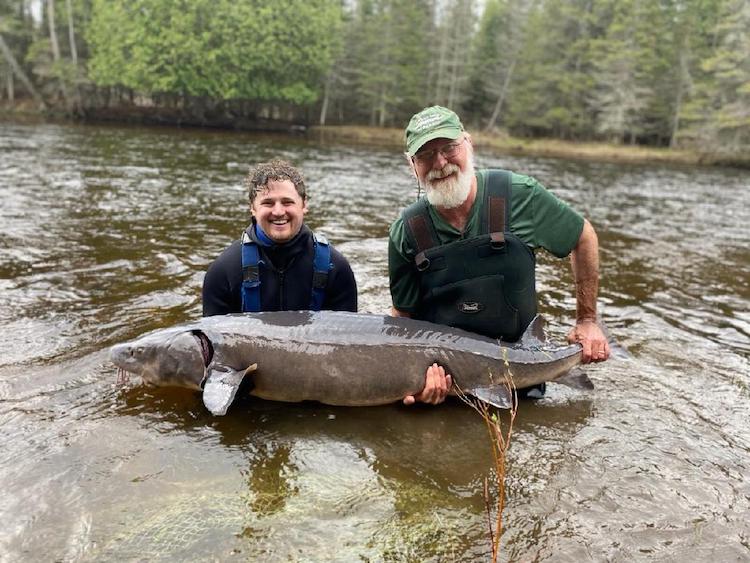
MSU Professor Emeritus Kim Scribner has helped lead the program for more than two decades and, when he retired in January, he passed the torch to Scott Colborne, assistant professor in the Department of Fisheries and Wildlife’s Quantitative Fisheries Center. Scribner said the rearing facility gives sturgeons a better chance of surviving so that the Great Lakes sturgeon populations can grow. They’re also conducting research that’s led to important discoveries in the sources and levels of mortality during sturgeon early life stages and levels of sturgeon genetic diversity, helping the DNR make more informed management decisions.
So far, the hatchery has helped to double the adult population of lake sturgeons in Black Lake, and it’s increased populations in other Michigan bodies of water. The goal is that one day sturgeons will be self-sufficient so that the rearing facility isn’t needed anymore, said Ed Baker, manager for the DNR Marquette Fisheries Research Station. The DNR wants recreational sportsmen to enjoy the annual sturgeon fishing season without putting the population at risk.
“We don’t want to be stocking lake sturgeon in perpetuity,” Baker said. “We want to get the population to the point that it can sustain the recreational harvest that is occurring without that harvest causing the population to decline again.”
Prehistoric fish
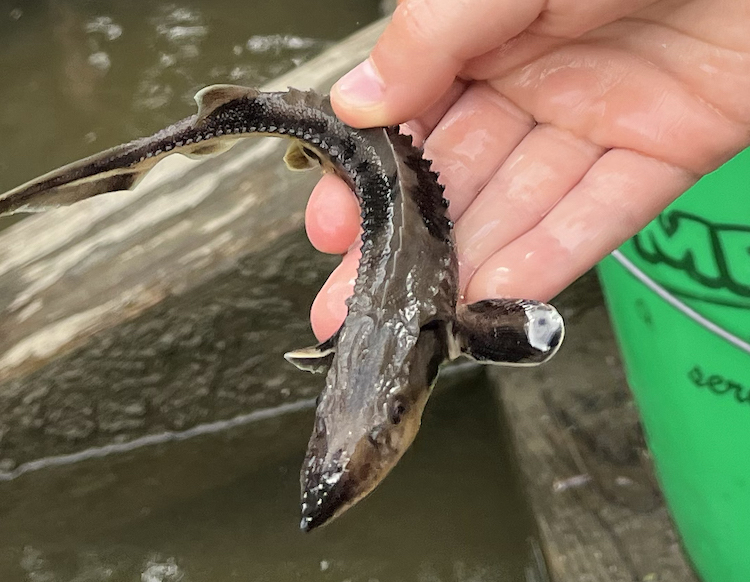
Lake sturgeons remind Colborne of African elephants. Much like the land giants, sturgeons are massive compared to the animals around them. Despite their size, they’re not predators. And there’s just something about them that Colborne can’t resist.
“They’re actually a very charismatic fish,” he said, a sentiment that’s echoed among others who’ve encountered the unique fish. “Once you interact with a sturgeon, you become fascinated by them.”
Lake sturgeon have barely changed in appearance through their 150-million-year history. With bony armor called scutes and a shark-like tail, they rightly earn their nickname of “living fossils.” They’re one of the oldest species to swim the Great Lakes and once were so plentiful that they were an important source of food for North American Indigenous tribes.
Sturgeons play an important role in nutrient cycling in the Great Lakes, Scribner said. As bottom feeders, they filter substrate through their gills and help distribute nutrients through the waters. They also eat invasive species like zebra mussels and round goby, helping to reduce their abundance.
The average lake sturgeon lives between 50 to 100 years, grows to about 4 to 6 feet long and weighs in at 30 to 80 pounds. However, they’re known to live up to 150 years, and they’ve been spotted as large as 8 feet long and as heavy as 300 pounds, according to Michigan Sea Grant.
Because they’re so large, they don’t have predators within the Great Lakes once they reach maturity. Humans are their main predator.
Vulnerable population
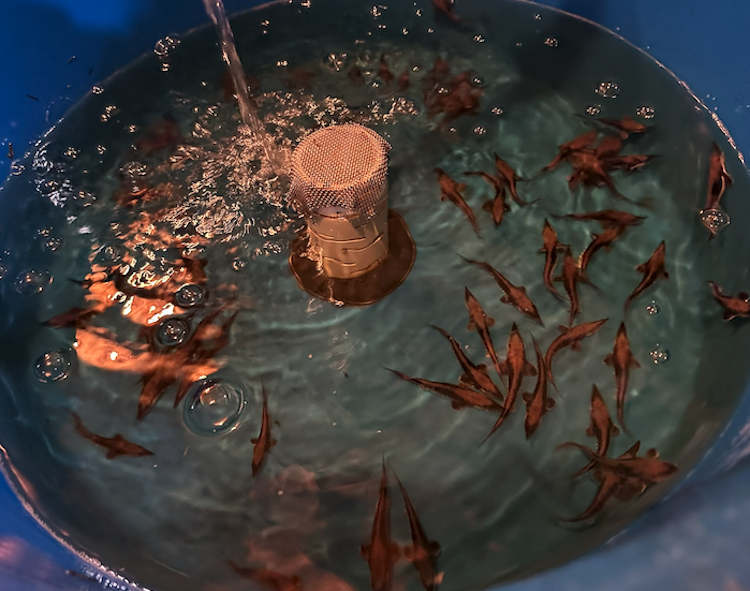
Like deer and other game animals, sturgeons have a harvest season, and any that are caught must be reported to the DNR. But that doesn’t stop some from attempting to harvest them outside of that season and in off-limits bodies of water. Baker realized there was a problem in 1997, when the DNR discovered that since 1975, the Black Lake sturgeon population had declined by 66%.
At the time, each angler was allowed to harvest one sturgeon per year. When Baker compared the number of missing sturgeons to the number that was legally harvested, there was major discrepancy. He knew lake sturgeons are especially vulnerable to poachers in rivers. Because they swim upstream there to spawn, they’re so focused on releasing eggs or sperm that they’re unaware of their surroundings.
“Most of the fish that were lost during that 20-plus-year period were harvested illegally,” Baker said.
Sturgeons can’t reproduce fast enough to keep up with the number being killed each year. Female sturgeons take more than two decades to reach sexual maturity, and males take at least 15 years. Even then, they might not spawn every year. They’re also inefficient spawners — females spread their eggs in the water column as the males release their sperm.
Human activity has made reproducing even more difficult, Scribner said. Climate change has caused both variable water temperatures and rainfall patterns that can impact spawning behaviors. Hydropower dams also not only kept some sturgeons from entering rivers to spawn, but they modified the fast, consistent water flow needed as sturgeons swim upstream and for egg incubation.
Even when sturgeons successfully spawn, their babies face an uphill battle to survive. Newly hatched sturgeons are about 20 millimeters long. For many other aquatic species, that’s the perfect size for their next meal. From sampling larvae in the river substrate and then sampling again downstream, MSU and DNR researchers learned that, left on their own, few of the larvae survive to the next life stage.
“A lot of things eat sturgeon eggs and sturgeon babies all the way through that first year of life,” Scribner said. “The mortality rate is extremely high.”
A shot at survival
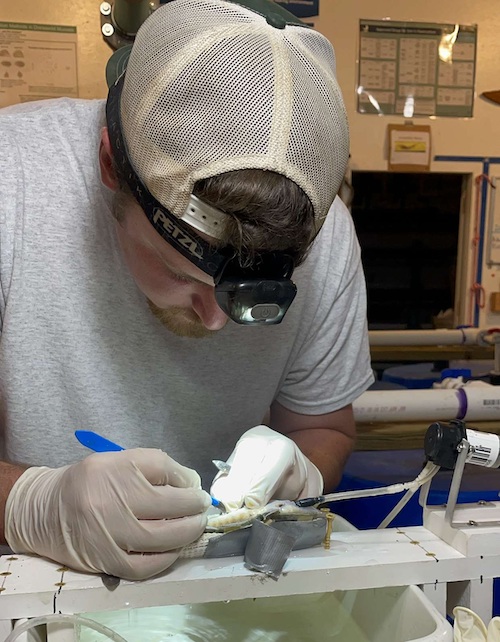
Letting lake sturgeons go extinct wasn’t an option. The DNR decided it was time for two major actions. First, in 2000, angling regulations were changed, and the sturgeon harvest was limited to four bodies of water in Michigan, and the harvest in Black Lake was limited to a lake-wide quote of six sturgeons per year. Second, it gave the sturgeon population a boost with a stocking program.
The Black Lake sturgeon research program began with a partnership between the DNR and Central Michigan University in 2000. MSU’s collaboration in the research began in 2002, when Scribner — then a professor in the Department of Fisheries and Wildlife — joined the project. It’s been a joint effort between MSU and the DNR ever since.
Undergraduate and graduate students are hired to conduct research and help care for the fish in the rearing facility. That’s how Max Majinska, a Fisheries and Wildlife graduate student, first came to the facility. Then a Northern Michigan University student, he helped collect embryos, assisted researchers with projects and made sure the sturgeons were fed and healthy. Since the moment he first held a baby sturgeon, he was hooked. So, when he graduated, Majinska decided to continue his studies at MSU and continue working at the hatchery.
That in-the-field experience was invaluable and helped him decide what he wants to do with his life.
“You can learn a lot from a classroom, but until you actually experience it, it’s just different,” Majinska said.
Each spring, field technicians and hatchery specialists use nets to catch juvenile larvae from the Black River, just as they’ve emerged from the river bottom when they’ve used their yolk sac and are hungry. Use of naturally produced larvae captured from the river helps to ensure they’re spawned by a large number of parents and are genetically diverse. Researchers also collect sperm and eggs from adults caught in the river to conduct experiments.
As the juvenile sturgeons grow, they’re kept in tanks filled with water that’s constantly flowing from the Black River and filtered for sand and particles, Colborne said. They’re fed brine shrimp multiple times a day, then bloodworms as they grow larger. Throughout their three months of care, they’re tested for diseases to be sure the juvenile fish are healthy.
Each fish is tagged with a Passive Integrated Transponder, or PIT tag, similar to a microchip you’d use for a pet dog or cat. It’s placed in their backs, about three to four scutes behind their heads. Then, in August, 500 6-inch baby sturgeons are released into the Black River. Sturgeons are also sent to Mullett Lake in Cheboygan County, the Boardman River in Grand Traverse County and the Cass, Shiawassee, Flint and Tittabawassee Rivers in the Saginaw River drainage.
Meanwhile, every aspect of the sturgeons and their care is studied. Over the years, researchers have learned ways to minimize mortality through feeding and care. They’ve adjusted the size at which they release sturgeons to give them a greater chance at surviving that critical first year of life when they’re most vulnerable, Scribner said.
Scribner estimates that sturgeons reared in the MSU/DNR facility have about a 75% survivorship rate for their first year of life. By the time they’re a year old, they’ve developed their bony armor and grown large enough that few predators remain. Sturgeons that live past one year have about a 95% survivorship rate to adulthood. That boost in survival has allowed the facility to rebuild the sturgeon populations.
“The hatchery is providing a more healthy, robust crop of sturgeons that are able to survive with higher probabilities,” Scribner said. “That all came about through research at the facility.”
Tracking success
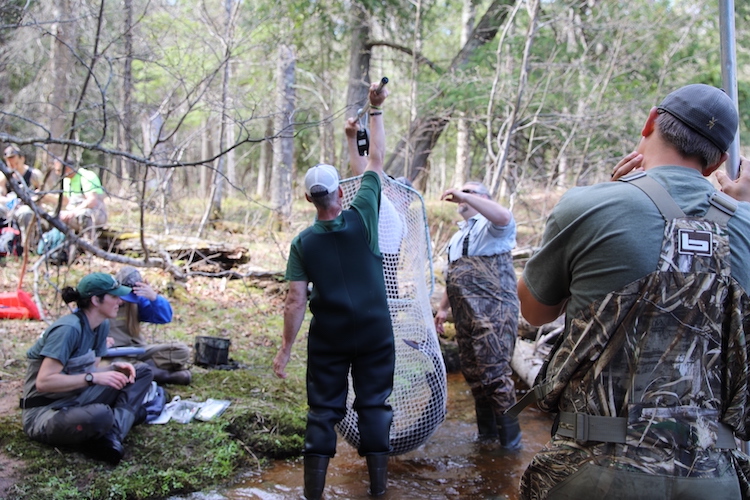
Every spring, field technicians don wetsuits and wade into the Black River for spawning season. They’re waiting when adult sturgeons return to the waters.
“I like to think you have to be a little bit crazy to do it,” Majinska said. “The best way to describe it is it’s like swimming in a rip current, and you add to that a compressive suit. But being that close to a giant is just surreal.”
As sturgeons swim into the river, they’re caught and measured for length, weight and girth, giving them an understanding of female egg production from year to year. Researchers also run genetic tests so that when they test larvae, they know which adults have offspring and are successfully reproducing, and under what stream conditions.
The sturgeons are counted and tagged if they don’t already have a PIT tag, allowing researchers to track which adults are returning to spawn year after year. A series of antennas are placed in the river so that tagged adults can be counted, even if they aren’t caught. While PIT tags have only been used for the past 10 years, they’re hoping to see facility-raised sturgeons return to the river in the next five years as they reach maturity, Colborne said.
Researchers use this “net survey” to estimate the Black Lake’s sturgeon population and how well the rearing program is working. Since it began, Black Lake’s adult lake sturgeon population has doubled from 600 to 1,200, Baker said.
Eventually, the goal is for the sturgeon population to reach 1,600 and be self-sustaining even as recreational fishing continues. Facility leaders are discussing whether they need to continue stocking the lake for the population to reach that level, Baker said.
Protecting the future
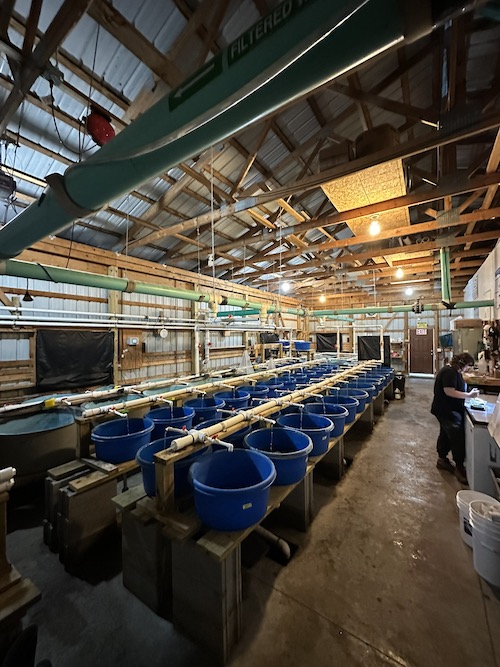
The DNR still allows fishers to spear and harvest lake sturgeons. The fish has been valuable to sportsmen for generations, and Baker believes it’s important to preserve that tradition. However, on Black Lake, the harvest season for state-licensed anglers is limited to five days, starting the first Saturday in February. Fishers cut holes in the ice and wait for sturgeons to swim by so they can attempt to spear them. Only six sturgeons are allowed to be caught by state-licensed anglers, and six are allowed by the tribal nations. Sometimes, that means sturgeon season is over within two hours. Eventually, Baker wants to increase harvest limits once the population can replace the sturgeons lost each year on its own.
“It’s very tightly regulated, but it’s very successful in protecting the population from over harvest,” Baker said.
To stop the illegal harvest by poachers, the DNR partners with community organization Sturgeon for Tomorrow’s Sturgeon Guarding Program. Each year, volunteers from the community and beyond sign up to stand guard along the Black River and report suspected poachers to a conservation officer. People gladly brave chilly temperatures for a chance to protect sturgeons and see the gentle giants up close as they swim into the river to spawn.
Community education is also a key part of securing the future for lake sturgeons. A program called Sturgeon in the Classroom allows schools around the state to care for a young sturgeon throughout the school year. Students are tasked with maintaining the tank, testing the water and feeding the sturgeon with bloodworms kept in a refrigerator. At the end of the school year, the sturgeons are tagged and released into a river near the school. Not only do students learn about the threatened species, but they also learn about their local watershed. The rearing facility works with MSU Extension and Michigan Sea Grant to reach out to schools and educators.
The community is also invited to Black Lake each August, when the young sturgeons are released into the wild.
As a land-grant university, Scribner said it’s MSU’s responsibility to reach out to the public and communicate the importance of our research. Sturgeons make it easy for researchers to talk about important issues such as climate change, dams and pollution, he said.
“The things that you want to inform the public about, the sturgeon is really a great ambassador to do that,” Scribner said. “It’s a pretty easy sell to people.”